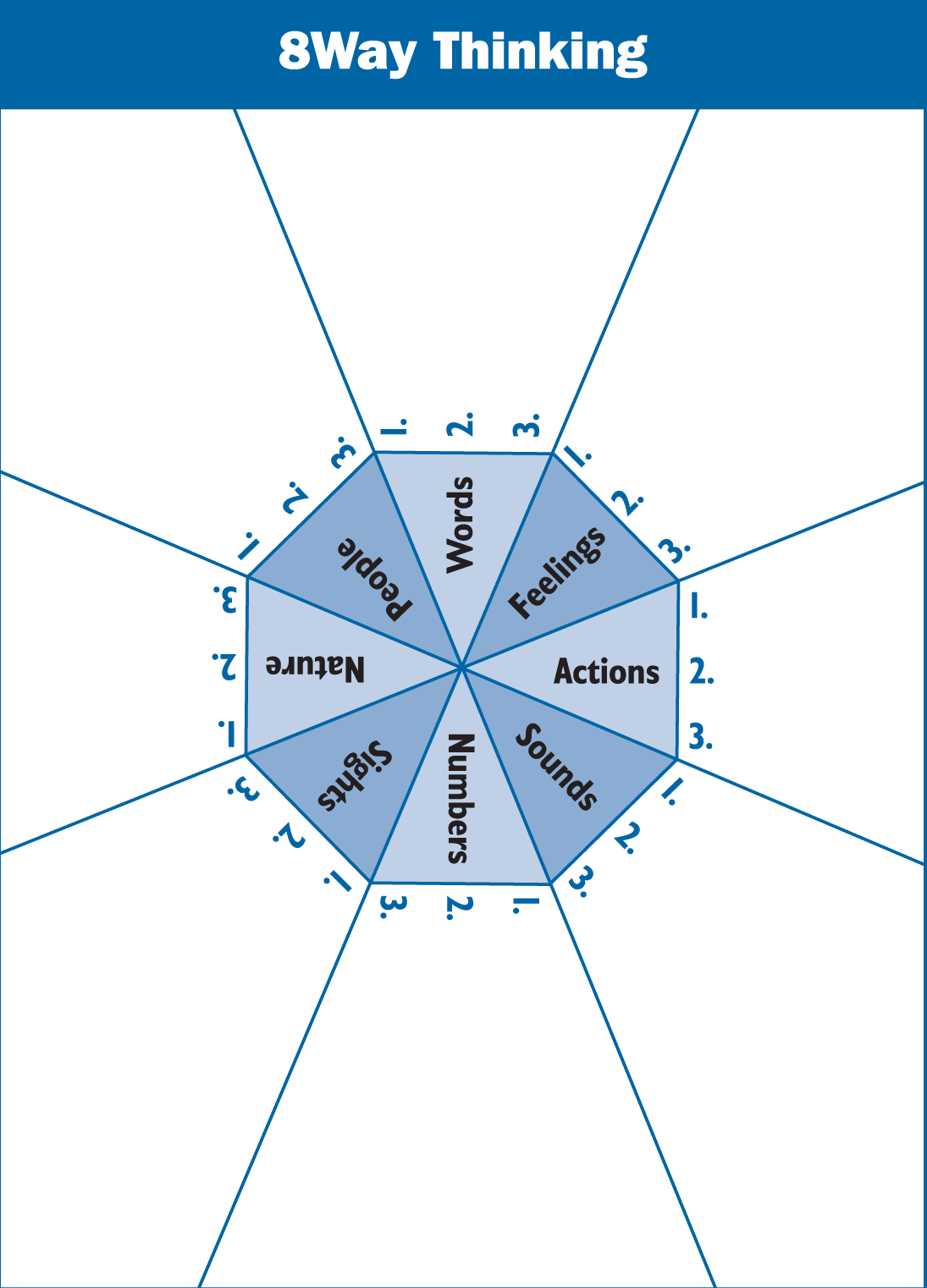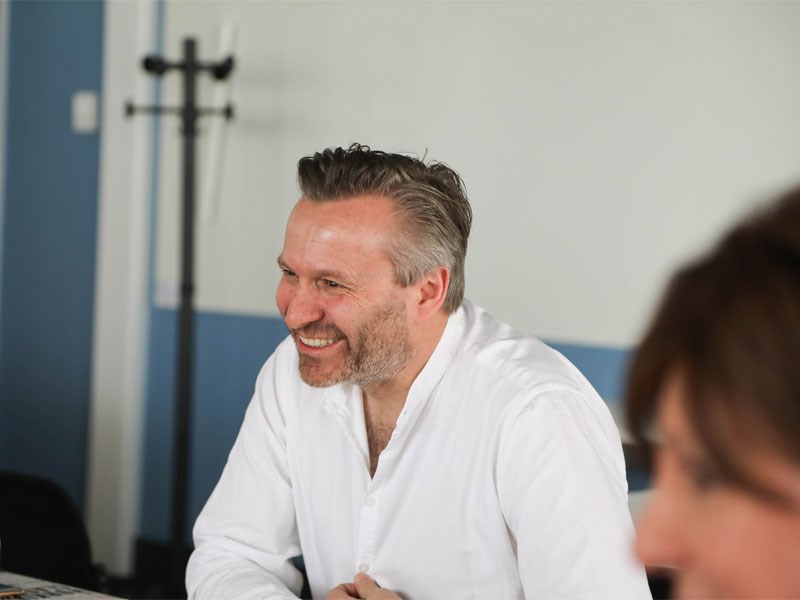8-Way Thinking
8-Way Thinking is a powerful thinking skills tool that combines principles from Philosophy for Children with Howard Gardner's Multiple Intelligence approach to what makes us tick. Here Ian Gilbert describes how he used it to reveal Grimsby's Fish Dock Number Two to be the most fascinating place on earth.

It was in Grimsby that 8-Way Thinking really came into its own.
To be somewhere as run down as Grimsby’s derelict fish docks and find it the most fascinating place in the world was quite a challenge. But it’s amazing what your brain can come up with when it tries.
We were en route from London to London the long way – a 2,500 mile circumnavigation of the British coast – to look at the smallest objects we could find (from grains of sand and the teeming, flicking plankton in the water) to the biggest (the second largest fish in the world and the world’s heaviest bony fish), the oldest (some of the most ancient rocks in the world, battered by the North Sea in Scotland), the sublime (sunset over John O’Groats, sunrise over Land’s End and the Milky Way in between) and even the ridiculous (what seemed like the population of Weymouth playing sardines on the beach during their regatta).
Around Deeply
‘Around Deeply’ was a three-month project to create a multi-dimensional snapshot of the people, places, history, sights, sounds and nature of our breathtaking coastal heritage. This unique project was, in essence, a thinking skills project, encouraging people to think, to reflect, to look more closely.
After all, the root of the word ‘curiosity’ is the same as the word ‘curator’ – to care for.
Asking someone to stop and think is easier said than done. It’s a bit like asking them to speak Polish or to be slim or think ‘outside the box’. It’s possible, just not straight away. However, what the De Bonos of this world have shown is that, given a structure, we can think better – more effectively, more thoroughly, more creatively and more deeply.
The structure that we had developed for the project drew on Howard Gardner’s famous multiple intelligence (MI) theory. With at least eight different intelligences to play with, the question isn’t ‘How smart are you?’ but ‘How are you smart?’ We then combined this with our work on Philosophy for Children (P4C), encouraging children to ask questions rather than just to settle for answers. P4C develops (or, perhaps, taps into) the natural curiosity of children and, from a ‘push-pull motivation’ standpoint, the learner starts to pull towards them answers to their own questions, rather than trying to fend off answers to questions they hadn’t even thought about.
A Multi-dimensional, Polycognitive Enquiry Tool Anyone?
Bringing together MI theory and P4C questioning led in a direct line to the multi-dimensional, polycognitive enquiry tool (for those of you writing your thesis) that we have called ‘8Way Thinking’.
In an office in the middle of Ipswich, waiting for the bank manager (who said he would be back in a minute) I spent half an hour doing an 8-Way Think on a derelict church on the busy roundabout outside the window. By working systematically through each of Gardner’s intelligences and asking questions about the church, I was immediately able to think differently about what I saw, creating a deep and tangible connection to something that I had driven past frequently and never really noticed. Questions such as:
-
-
- Naturalistic - What wildlife lives in the old churchyard?
- Physical - Where are the bricks from and how were they made?
- Linguistic - What was the name of the church and how did it get it?
- Visual - What different geometric patterns are there in the structure of the tower?
- Logical/mathematical - How long was it open for, when did it close and why?
- Interpersonal - How does it feel to stand in such a place?
- Musical - What were the very first and very last hymns sung there?
- Intrapersonal - Does a church that is not longer a church feel like a church that still is a church?
-
Even though we may never know the answers to all of these questions, that doesn’t make asking them any less powerful. After all, as an Australian rabbi once said, ‘I’m not looking for answers that make the questions go away’.
Just by being curious in this structured way, you make Proust (who is misquoted as saying that the true journey of discovery is more about looking at places with new eyes than seeing new places) a happy man.
Remember, an answer is a ‘.’ A question is a ‘...’
The next step was to simplify the vocabulary used from Gardner's original terminology to something easier for children to grasp:
-
-
- From Intrapersonal to People
- From Logical/Mathematical to Numbers
- From Verbal/Linguistic to Words
- From Natural to Nature
- From Musical to Sounds
- From Interpersonal to Feelings
- From Visual/Spatial to Sights
- From Bodily/Kinaesthetic to Actions.
-
This can then easily be transferred into a physical model, such as an octahedron or, if your origami is as goods as ours, a simple octagon.
Dogs, Love, Cheese and Manchester United
Then for anything in the world you want to think about, (dogs, love, cheese, Manchester United, weather, the Egyptians, the rainforests and yes, even Grimsby), you have a model for asking questions, curiosity, thinking deeply and seeing with new eyes.
This meant that in the Dickensian squalor of Grimsby Fish Dock Number Two, we could ask such questions as:
People: What sort of jobs did people do here and what was their daily life like?
‘Lumpers’ used to walk to work in their clogs every morning, on their way to hump boxes of fish between the quayside and the boats.
Numbers: How many dockworkers were there in its heyday?
There were 75,000 people in the 1890s, with 700 trawlers. Interestingly, more fish is brought in now to be processed than ever before, but by road from Scandinavia. The rotting fish heads are left outside in large bins for curious thinkers...
Words: What local accents and dialogues can be found here?
We spoke to Bill, a former trawlerman who spoke in his broad local accent. We saw the signs in the old ice factory asking you not to ‘eat, drink, smoke or spit’.
Naturalistic: What species of birds and plants live here?
You’d be amazed what this apparently barren wasteland holds – including meadow pipits and a huge one-eyed seal.
Sounds: What can you hear now compared to one hundred years ago?
Meadow pipits are the loudest sounds now. In its heyday the celebrated ice factory would send 1,100 tons of ice a day crashing down the ice shoots, into the holds of the waiting trawlers or into the fast train to London restaurants.
Feelings: What does it feel like to see this place now, knowing what it was like even 30 years ago?
‘Sad’ is the word Bill came back with, when we asked him, describing how he helped his father ‘pull the fires’ on one of Grimsby’s last steam-driven trawlers.
Sights: What did the docks look like in their heyday and what makes it beautiful now?
We were shown a picture of the spot where we were berthed, taken one hundred years ago. It was solid forest of masts. The photos we took (see more here) included this one of the engines in a wrecking yard where we watched the ritual disembowelling of scrapped cars.
Actions: What was the physical process of trawling?
Bill told us how, in a time before electronic navigation equipment, he would go fishing alone with just a lead line and a compass. He also explained that he was seasick nearly every day of his working life!
Easy really!
This process of asking questions formed the essential structure of Around Deeply and allowed us to create a unique overview of our wonderful coastal heritage. But you don’t have to go to Grimsby to contemplate the wonders of the world.
Template
The 8-Way Thinking template is based around a model I put together with my ten-year old daughter for a presentation to her class on London.

After putting ‘London’ in the middle of the octahedron (see image), we then worked our way around the edges coming up with three questions per section. She then found out as many answers as she could and used the entire document as the basis for her class talk. For a child who isn’t too comfortable with lines of text on a page, this model proved to be a very useful tool (and one we haven’t seen since the curious teacher took it away to use herself).
Once you get the hang of 8-Way Thinking, you don’t have to use the octahedron model all the time – think big!
Large Scale 8-Way Thinking
One primary school turned their hall into one big MI area, to do 8-Way Thinking on a large scale. So, rather than having a display on, say, weather, covering one wall and a display about animals on another, they were going to take one theme and spread it around the entire room. So, on one wall there was a display about what weather looked like, with famous pictures of weather and paintings by the children; on another statistics about weather; on yet another weather words and poems and so on...
I can try and make 8-Way Thinking more complicated for you if you wish. The truth is, it is very simple and the best way of getting to grips with it is to have a go yourself. Feel free to adapt and play around with it and let me know how you get on.
If ever you’re in Grimsby, head down to Fish Dock Number Two and have a good deep think!
This article first appeared in Teaching Expertise magazine, Issue 12 ● Summer 2006 Creativity

Call us on +44(0)1267 211432 or email learn@independentthinking.co.uk for a chat about working with Ian and for details on how to save money when you book.
Enjoy a free consultation. Make a booking.
Haggle a bit. All acceptable.
Give us a call on +44 (0)1267 211432 or drop us a line at learn@independentthinking.co.uk.
We promise to get back to you reassuringly quickly.

About the author
Ian Gilbert
Ian Gilbert is an award-winning writer, editor, speaker, innovator and the founder of Independent Thinking. He has lived and worked in Europe, the Middle East, South America and Asia and is privileged to have such a global view of education and education systems.